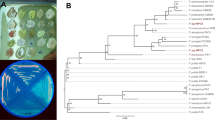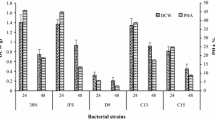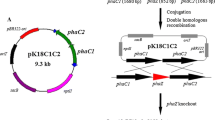Abstract
A newly isolated strain, designated as Pseudomonas sp. DSY-82, synthesized medium-chain-length polyhydroxyalkanoate (MCL-PHA) copolyesters when grown on alkanoates from hexanoate to undecanoate as the sole carbon source. When used alone, butyrate and valerate supported the growth of the isolate but not PHA production. However, unusual polyesters containing 3-hydroxyvalerate, as well as various MCL 3-hydroxyalkanoate monomeric units, were synthesized when valerate was cofed with either nonanoate or 10-undecenoate, suggesting the formation of monomer units from both substrates. Concentrations of 3-hydroxyvalerate, 3-hydroxyoctanoate, and 3-hydroxydecanoate in the PHAs produced were significantly elevated by the addition of valerate, indicating that the incorporation of these monomer units to PHA occurred primarily through cometabolism. The total amount of these monomer units in the PHAs reached up to 30%. The PHAs produced in this study were most likely random copolyesters as determined by differential scanning calorimetric analysis. This is the first case of microbial synthesis of copolyesters consisting of 3-hydroxyvalerate and MCL 3-hydroxyalkanoate monomer units through cometabolism.
Similar content being viewed by others
References
Brandle H, Gross RA, Lenz RW, Lloyd R & Fuller RC (1991) The accumulation of poly(3-hydroxyalkanoates) in Rhodobacter sphaeroides. Arch. Microbiol. 155: 337-340
Choi MH & Yoon SC (1994) Polyester biosynthesis characteristics of Pseudomonas citronellolis grown on various carbon sources including 3-methyl-branched substrates. Appl. Environ. Microbiol. 60: 3245-3254
Chun J (1995) Computer-assisted classification and identification of actinomycetes. Ph.D. thesis. University of Newcastle upon Tyne, UK
Chung CW, Kim YS, Kim YB, Bae KS & Rhee YH (1999) Isolation of a Pseudomonas sp. strain exhibiting unusual behavior of poly(3-hydroxyalkanoates) biosynthesis and characterization of synthesized polyesters. J. Microbiol. Biotechnol. 9: 847-853
Doi Y, Kawaguchi Y, Koyama N, Nakamura S, Hiramitsu M, Yoshida Y & Kimura H (1992) Synthesis and degradation of polyhydroxyalkanoates in Alcaligenes eutrophus. FEMS Microbiol. Rev. 103: 103-108
Doi Y, Kitamura S & Abe H (1995) Microbial synthesis and characterization of poly(3-hydroxybutyrate-co-3-hydroxyhexanoate). Macromolecules 28: 4822-4828
Eggink G, de Waard P & Huijberts GNM (1995) Formation of novel poly(hydroxyalkanoates) from long-chain fatty acids. Can. J. Microbiol. 41(Suppl. 1): 14-21
Kato M, Bao HJ, Kang CK, Fukui T & Doi Y (1996) Production of a novel copolyester of 3-hydroxybutyric acid and medium-chainlength 3-hydroxyalkanoic acids by Pseudomonas sp. 61-3 from sugar. Appl. Microbiol. Biotechnol. 45: 363-370
Kim DY, Kim YB & Rhee YH (1998) Bacterial poly(3-hydroxyalkanoates) bearing carbon-carbon triple bonds. Macromolecules 31: 4760-4763
Kim DY, Kim YB & Rhee YH (2000) Evaluation of various carbon substrates for the biosynthesis of polyhydroxyalkanoates bearing functional groups by Pseudomonas putida. Int. J. Biol. Macromol. 28: 23-29
Kim YB, Lenz RW & Fuller RC (1995) Poly-3-hydroxyalkanoates containing unsaturated repeating units produced by Pseudomonas oleovorans. J. Polym. Sci. (Part A: Polym. Chem.) 33: 1367-1374
Kim YB, Rhee YH, Han SH, Heo GS & Kim JS (1996) Poly-3-hydroxyalkanoates produced from Pseudomonas oleovorans grown with ω-phenoxyalkanoates. Macromolecules 29: 3432-3435
Lageveen RG, Huisman GW, Preusting H, Ketelaar P, Eggink G & Witholt B (1988) Formation of polyesters by Pseudomonas oleovorans: effect of substrates on formation and composition of poly-(R)-3-hydroxyalkanoates and poly-(R)-3-hydroxyalkenoates. Appl. Environ. Microbiol. 54: 2924-2932
Lane DJ (1991) 16S/23S rRNA sequencing. In: Stackebrandt E & Goodfellow M (Ed) Nucleic Acid Techniques in Bacterial Systematics (pp 115-175). Wiley & Sons, Chichester, UK
Lee DH, Zo YG & Kim SJ (1996) Nonradioactive method to study genetic profiles of natural bacterial communities by PCR-singlestrand-conformation polymorphism. Appl. Environ. Microbiol. 62: 3112-3120
Lee EY, Jendrossek D, Schirmer A, Choi CY & Steinbüchel A (1995) Biosynthesis of copolyesters consisting of 3-hydroxybutyric acid and medium-chain-length 3-hydroxyalkanoic acids from 1,3-butanediol or from 3-hydroxybutyric acid by Pseudomonas sp. A33. Appl. Microbiol. Biotechnol. 42: 901-909
Lee SH, Oh DH, Ahn WS, Lee Y, Choi J & Lee SY (2000) Production of poly(3-hydroxybutyrate-co-3-hydroxyhexanoate) by high-cell-density cultivation of Aeromonas hydrophila. Biotechnol. Bioeng. 67: 240-244
Lenz RW, Kim YB & Fuller RC (1992) Production of unusual bacterial polyesters by Pseudomonas oleovorans through cometabolism. FEMS Microbiol. Rev. 103: 207-214
Liebergessel M, Hustede E, Timm A, Steinbüchel A, Fuller RC, Lenz RW & Schlegel HG (1991) Formation of poly(3-hydroxyalkanoates) by phototrophic and chemolithotrophic bacteria. Arch. Microbiol. 155: 415-421
Liebergessel M, Mayer F & Steinbüchel A (1993) Analysis of polyhydroxyalkanoic acid-biosynthesis genes of anoxygenic phototrophic bacteria reveals synthesis of a polyester exhibiting an unusual composition. Appl. Microbiol. Biotechnol. 40: 292-300
Madison LL & Huisman GW (1999) Metabolic engineering of poly(3-hydroxyalkanoates): from DNA to plastic. Microbiol. Mol. Biol. Rev. 63: 21-53
Palleroni NJ (1984) Genus Pseudomonas. In: Krieg NR & Holt JG (Ed) Bergey's Manual of Systematic Bacteriology, Vol 1 (pp 141-199). The William & Wilkins Co., Baltimore, MD, USA
Preusting H, Nijenhuis A & Witholt B (1990) Physical characteristics of poly(3-hydroxyalkanoates) and poly(3-hydroxyalkenoates) produced by Pseudomonas oleovorans grown on aliphatic hydrocarbons. Macromolecules 23: 4220-4224
Shimamura E, Kasuya K, Kobayashi G, Shiotani T, Shima Y & Doi Y (1994) Physical properties and biodegradability of microbial poly(3-hydroxybutyrate-co-3-hydroxyhexanoate). Macromolecules 27: 878-880
Steinbüchel A & Valentin HE (1995) Diversity of bacterial polyhydroxyalkanoic acids. FEMS Microbiol. Lett. 128: 219-228
Steinbüchel A & Wiese S (1992) A Pseudomonas strain accumulating polyesters of 3-hydroxybutyric acid and medium-chainlength 3-hydroxyalkanoic acids. Appl. Microbiol. Biotechnol. 37: 691-697
Timm A, Byrom D & Steinbüchel A (1990) Formation of blends of various poly(3-hydroxyalkanoic acids) by a recombinant strain of Pseudomonas oleovorans. Appl. Microbiol. Biotechnol. 33: 296-301
Witholt B & Kessler B (1999) Perspectives of medium chain length poly(hydroxyalkanoates), a versatile set of bacterial bioplastics. Curr. Opin. Biotechnol. 10: 279-285
Xi J, Wu Q, Yan Y, Zhang Z, Yu PHF, Cheung M, Zhang R & Chen GQ (2000) Hyperproduction of polyesters consisting of medium-chain-length hydroxyalkanoate monomers by strain Pseudomonas stutzeri 1317. Antonie van Leeuwenhoek 78: 43-49
Yao J, Zhang G, Wu Q, Chen GQ & Zhang R (1999) Production of polyhydroxyalkanoates by Pseudomonas nitroreducens. Antonie van Leeuwenhoek 75: 345-349
Author information
Authors and Affiliations
Corresponding author
Rights and permissions
About this article
Cite this article
Kang, H.O., Chung, C.W., Kim, H.W. et al. Cometabolic biosynthesis of copolyesters consisting of 3-hydroxyvalerate and medium-chain-length 3-hydroxyalkanoates by Pseudomonas sp. DSY-82. Antonie Van Leeuwenhoek 80, 185–191 (2001). https://doi.org/10.1023/A:1012214029825
Issue Date:
DOI: https://doi.org/10.1023/A:1012214029825




